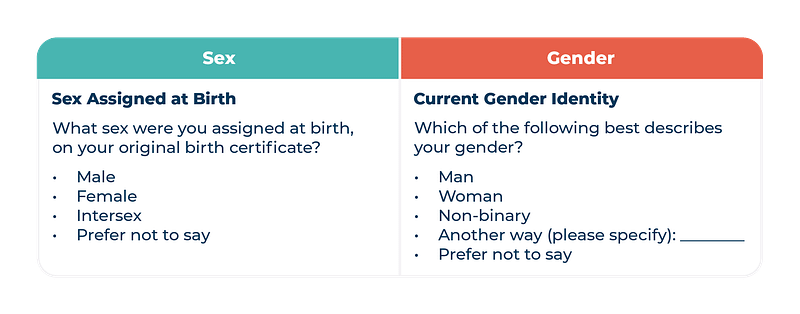Healthcare providers increasingly recognise the importance of collecting accurate data on sex and gender to deliver equitable, person-centred care. However, these topics are sensitive and nuanced, requiring thoughtful survey design to ensure respondents feel respected and represented. In this article, we outline evidence-based best practices for asking gender and sex questions in surveys.
“Also finally, on this form, male, female, non-binary and transgender are all separate and only one can be ticked. It would be more appropriate to have multi-check boxes, otherwise it suggests that trans people are not real men or women, or that you can’t be non-binary and trans.” – Patient Feedback
What is the difference between Sex and Gender?
Understanding and clearly differentiating between the concepts of sex and gender is foundational.
- Sex is about biology – typically refers to biological attributes such as chromosomes, hormones, and anatomy and is noted on birth certificates as the biological sex.
- Gender is about identity – a person’s internal sense of identity, which may or may not align with the sex they were assigned at birth.
Best Practice: To maintain clarity and ensure accurate data collection, ask about sex and gender in separate questions [3][5][6].
Different terms to consider when asking about sex
When asking people about their sex, we want to make it clear that we are asking about sex and not gender. To do this it is common to refer to ‘sex assigned at birth’, or ‘birth sex’, or ‘biological sex’. Alternatively, we might say ‘your sex noted on your original birth certificate’.
All these options are considered respectful and accurate.
Why you are asking?
Respondents are more likely to provide information when they understand its purpose. Prior to presenting any demographic or additional questions in a survey, a brief explanation of their purpose can make a big difference to people’s willingness to answer.
For example, you might state that the data is used to support healthcare equity, to inform service improvements, or monitor inclusion efforts. Transparency about how this data will be used helps build trust and improves participation.
Remember, not every survey requires questions about sex and/or gender. Only include these questions when responses are going to be used.
Designing your survey questions
Be Precise
Do not merge gender and sex. Doing so can cause confusion and alienate respondents. Which of these do you need to know, if either?
Provide a ‘Prefer Not to Say’ Option
Because gender and sex are personal topics, respondents should be given the choice not to disclose this. Including a “prefer not to say” option acknowledges the sensitive nature of these questions and helps maintain participants’ comfort and autonomy [4][5][6].
Keep Questions Optional
Making these questions optional rather than mandatory avoids pressuring individuals to share information they may not be comfortable disclosing, which in turn helps prevent survey dropouts [3][5].
Best Practice Questions
Please note: Using inclusive language like we’ve shown above ensures accurate representation and fosters trust among LGBTQ+ respondents [1][5][6].
Offering a write-in/self-describe option recognises that gender diversity involves more than just offering a list of options. Because labels like ‘non-binary’ might not reflect everyone’s identity, a self-describe field gives people space to express their gender in their own words, making surveys more inclusive and respectful [1][5][6].
Key Recommendations
- Separate questions: Ask about sex and gender individually
- Inclusive options: Include “non-binary”, “in another way”, and free text/self-describe
- Opt-out: Always provide “prefer not to say”
- Clear language: Specify if asking about sex at birth or current gender
- Justification: Explain why data is being collected
Asking about sex and gender in healthcare surveys is essential for understanding patient needs and advancing health equity. When done thoughtfully—with clear distinctions, inclusive language, optionality, transparency, and community engagement—these questions can support the delivery of respectful and responsive care. By following these best practices, healthcare providers can ensure they collect meaningful, representative data while upholding the dignity of every individual [1][3][4][5][6].



